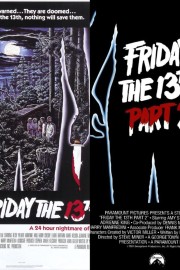Friday the 13th & Friday the 13th: Part 2
Although it spawned the longest-running slasher franchise, with 10 films over 22 years, Sean S. Cunningham’s “Friday the 13th” has always been seen, by critics at least, as the runt of the horror movie litter. It’s understandable, considering it came after two landmarks (“Texas Chainsaw Massacre” and “Halloween”) and was followed by another one four years later (“A Nightmare on Elm Street”). However, over the years, the 1980 original stands up well against any of those movies.
It’s always been MY favorite horror franchise. I began watching the movies back in the ’80s, before I really understood what I was watching. I saw the first six films in the franchise, as well as the TV series. I wrote my own entries in the series. Of course, they were crude, but certainly enough to get the attention of my mother, who was disturbed by my fascination with Jason, the series’s perpetually-regenerative killer. From 1987 until 2002, I stopped watching the films, although I picked the series up again with the deservedly-maligned “Jason X,” followed by the next year’s team-up film, “Freddy vs. Jason.” I would eventually finish watching the series by the time the reboot came out in 2009, by which point, it returned as a regular part of my horror movie watching. Well, some of the movies would…starting with the first two.
Why review the first two together? Because even though they were written and directed by different people, they represent a natural, continuous narrative, which is something that later entries would have difficulty with, not including the Tommy Jarvis era from parts 4-6. This was helped by writer Victor Miller’s inspired choice of Jason Vorhees’s mother as the killer in the 1980 original. You see, back in 1957, young Jason drowned at Camp Crystal Lake when two counselors failed to pay attention. The next year, a pair of counselors were murdered at the camp, which was never reopened…until twenty years later. All the while, Mrs. Vorhees (Betsy Palmer) remained in the woods, ready to begin the cycle of death over again. Now, a new generation of fresh meat, I mean “camp counselors,” is back to sate Mrs. Vorhees’s desire for blood.
To be fair, “Friday the 13th” has never been the most ingenious series; it basically amounts to getting a group of young, horny people together for the antagonist to take out, one at a time. But the first two films, helped out by that circular narrative of the mother avenging the son, who will then avenge the mother, are made of more interesting stuff. Yes, Miller and Cunningham were obviously inspired by John Carpenter’s “Halloween,” but they created an equally-intriguing mythology surrounding the Vorhees family that allowed for real suspense, and a palpable danger, to creep into their film.
Of course, like “Halloween,” they had a secret weapon in an unforgettable musical theme by Henry Manfredini. The entire score, not the last he would write for the series, is terrific, but that destinctive theme, with its bizarre vocal effects, and elements of iconic themes like “Halloween” and “Psycho,” is one of the most famous horror movie history for good reason. By the time Alice (Adrienne King) is found by police after Mrs. Vorhees’s reign of terror is over, Manfredini’s music, as well as Crystal Lake and the Vorhees clan, are embedded as a permanent part of modern horror iconography.
Watching “Part 2” immediately after the original, it occurred to me just how derivative it is from the first one. Yes, it properly introduces Jason Vorhees to the canon, but except for the first 12 minutes, in which Jason does away with Alice (the lone survivor from the first film), and the final 10-20 minutes, when Ginny (Amy Steel) learns the macabre truth for herself, and figures out an ingenious way to kill Jason, this is standard slasher movie fare. That doesn’t make the sequel, written by Ron Kurz, and directed by Steve Miner, bad, but it does deflate a lot of the tension from the film. That makes the film more of an exercise in gratuitous violence and nudity than a standard-bearer in the same vein of the original movie, but for what it adds to the mythology of Camp Crystal Lake (also known as Camp Blood), it does deserve to be considered with Cunningham and Miller’s original film.










